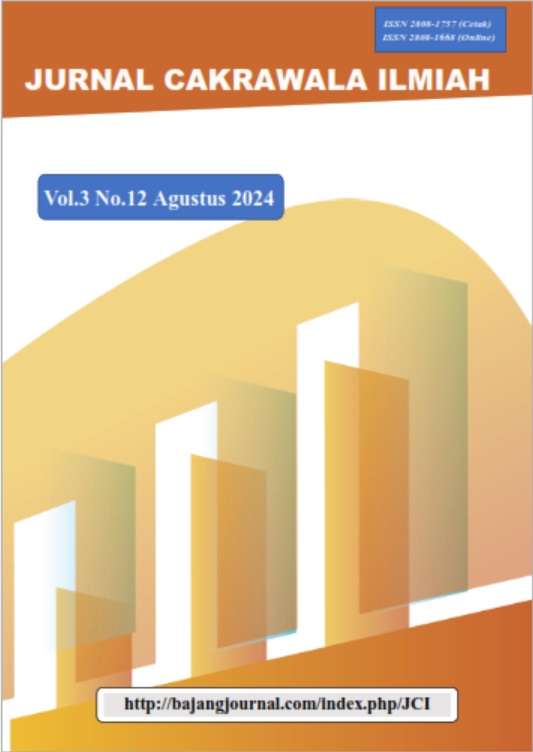REVIEW PENGENDALIAN LIMBAH PADAT SERTA BAHAN BERBAHAYA (B3) DI RUMAH SAKIT
Keywords:
Solid Waste, Hospital, Toxic MaterialAbstract
Health waste is waste generated from health activities it hospitals. Hospital operations generate a variety of waste byproducts, solid waste that contain hazardous and poisonous bacteria. Operational activities and B3-containing service facilities generate hazardous and toxic waste. The purpose of this study is to learn more about and gain an understanding of how hospitals handle hazardous and toxic chemicals (B3) and solid waste. The purpose of this study is to learn more about and understand how hospitals handle hazardous and toxic materials (B3) as well as solid waste. A review of the literature sourced from reputable pharmaceutical publications, PubMed, Google Scholar, and other literature search results is the methodology employed. The analysis chosen articles was of the hospital's solid and (B3) waste management system. From the literature search, 7 journals out of 1,910 articles were found that matched the criteria with the search string 2015 to 2024. The study's findings demonstrated the necessity of trash sorting for the efficient management of hazardous chemicals (B3) and solid waste in hospitals. collection and destruction. Techniques such as incineration of medical waste and proper segregation of non-medical waste are important to prevent negative impacts on health and the environment.
References
Alfian, Lutfi, dan Windi Wulamdari. “Penerapan Pengelolaan Limbah Padat Medis Rumah Sakit Swasta X Sukoharjo.” Jurnal Kesmas Asclepius 5, no. 2 (9 Desember 2023): 167–75. https://doi.org/10.31539/jka.v5i2.7846.
Egbenyah, Fredrick, Emilia Asuquo Udofia, Jesse Ayivor, Mary-Magdalene Osei, John Tetteh, Patience B. Tetteh-Quarcoo, dan Eric Sampane-Donkor. “Disposal habits and microbial load of solid medical waste in sub-district healthcare facilities and households in Yilo-Krobo municipality, Ghana.” Diedit oleh Reginald B. Kogbara. PLOS ONE 16, no. 12 (10 Desember 2021): e0261211. https://doi.org/10.1371/journal.pone.0261211.
Farzadkia, Mahdi, Somayeh Golbaz, Mohammad M Emamjomeh, dan Haniye Sadat Sajadi. “An Investigation On Hospital Solid Waste Management In Iran.” Global NEST Journal 17, no. 4 (2015): 771–83. https://doi.org/10.1504/WRSTSD.2015.073820.
Firdaus, Nata. “Analisis Pengolahan Limbah Padat Rumah Sakit Bhayangkara Kota Palangka Raya Kalimantan Tengah.” Sultan Agung Fundamental Research Journal 2, no. 1 (2021): 41–64. https://jurnal.unissula.ac.id/index.php/safrj/article/view/13583/5127.
Maulana, Muchsin, Hari Kusnanto, dan Agus Suwarni. “Sistem Kontrak Pengolahan Limbah Padat Rumah Sakit Pemerintah.” Jurnal Kesehatan Masyarakat 9, no. 1 (2015): 69–76.
Pratama, Sinta Debi, Endang Budiati, dan Dian Utama Pratiwi Putri. “Gambaran Pengelolaan Limbah Padat Bahan Berbahaya dan Beracun (B3) Fasilitas Pelayanan Puskesmas di Kota Bandar Lampung.” Jurnal Kesehatan 14, no. 1 (2023): 157–64. https://doi.org/10.26630/jk.v14i1.2868.
Purwanti, Alvionita Ajeng. “PENGELOLAAN LIMBAH PADAT BAHAN BERBAHAYA DAN BERACUN (B3) RUMAH SAKIT DI RSUD Dr.SOETOMO SURABAYA.” Jurnal Kesehatan Lingkungan 10, no. 3 (2018): 291–98. https://doi.org/10.20473/jkl.v10i3.2018.291-298.
Samaritan, Dwi Lassmy, dan Surahma Asti Mulasari. “Gambaran Manajemen Pengelolaan Limbah Padat Di Health Centre Perusahaan X Lampung Tengah.” Jurnal Medika Respati 10, no. 4 (2015): 71–87. http://medika.respati.ac.id/index.php/Medika/article/view/106.
Siddik, Salma Savira, dan Eka Wardhani. “Pengelolaan Limbah B3 Di Rumah Sakit X Kota Batam.” Jurnal Serambi Engineering 5, no. 1 (2020): 760–67. https://doi.org/10.32672/jse.v5i1.1602.
Downloads
Published
How to Cite
Issue
Section
License
Copyright (c) 2024 Jurnal Cakrawala Ilmiah

This work is licensed under a Creative Commons Attribution-NonCommercial 4.0 International License.
















